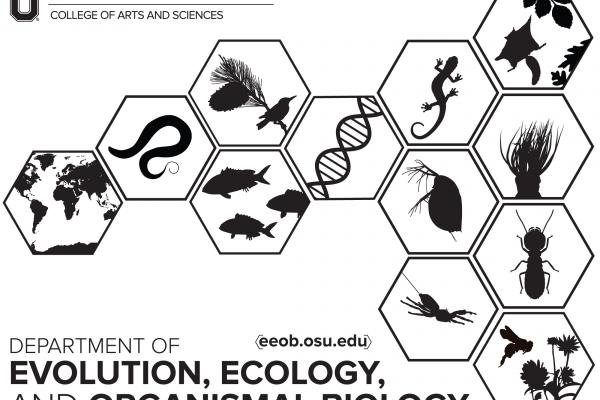Publications by EEOB faculty November 1 - November 30

Two isoforms of Pepck in Sarcophaga bullata and their distinct expression profiles through development, diapause, and in response to stresses of cold and starvation
Drew E. Spacht, Nicholas M.Teets, David L. Denlinger. 2018. Journal of Insect Physiology. https://doi.org/10.1016/j.jinsphys.2018.10.008
Abstract
Pepck is a metabolic enzyme that participates in gluconeogenesis through the conversion of oxaloacetate into phosphoenol pyruvate. Numerous transcriptomic studies have identified Pepck as a potential key player during diapause and various stresses responses. Here, we describe expression patterns of both cytosolic and mitochondrial isoforms of Pepck throughout development, during diapause, and in response to starvation and cold shock in the flesh fly, Sarcophaga bullata. We cloned full-length transcripts for both Pepck isoforms and observed that expression of both genes varied throughout development. Diapausing pupae have the highest relative expression of both isoforms, suggesting participation in the anticipatory production of sugars and sugar alcohols that occurs during this overwintering stage. In response to acute stress, the cytosolic isoform was upregulated whereas the mitochondrial variant remained unchanged. Cytosolic Pepck was strongly upregulated after 2 h recovery from cold shock and returned to baseline levels within 8 h. In response to 24 h of starvation, the cytosolic isoform was similarly upregulated and returned to control levels after 24 h of recovery. Acute stress is known to incur a metabolic cost, and Pepck could be a key player in this response. Although it remains unclear why there is such a dramatic divergence in the expression of the two isoforms, the distinction suggests specific roles for the two isoforms that depend on the developmental status of the fly and the stress conditions to which it is exposed.
Genetic signatures of small effective population sizes and demographic declines in an endangered rattlesnake, Sistrurus catenatus
Michael Sovic, Anthony Fries, Scott A. Martin, and H. Lisle Gibbs. 2018. Evolutionary Applications. doi: 10.1111/eva.12731
Abstract
Endangered species that exist in small isolated populations are at elevated risk of losing adaptive variation due to genetic drift. Analyses that estimate short-term effective population sizes, characterize historical demographic processes, and project the trajectory of genetic variation into the future are useful for predicting how levels of genetic diversity may change. Here, we use data from two independent types of genetic markers (single nucleotide polymorphisms [SNPs] and microsatellites) to evaluate genetic diversity in 17 populations spanning the geographic range of the endangered eastern massasauga rattlesnake (Sistrurus catenatus). First, we use SNP data to confirm previous reports that these populations exhibit high levels of genetic structure (overall Fst = 0.25). Second, we show that most populations have contemporary Ne estimates less than 50. Heterozygosity-fitness correlations in these populations provided no evidence for a genetic cost to living in small populations, though these tests may lack power. Third, model-based demographic analyses of individual populations indicate that all have experienced declines, with the onset of many of these declines occurring over timescales consistent with anthropogenic impacts (<200 years). Finally, forward simulations of the expected loss of variation in relatively large (Ne = 50) and small (Ne = 10) populations indicate they will lose a substantial amount of their current standing neutral variation (63% and 99%, respectively) over the next 100 years. Our results argue that drift has a significant and increasing impact on levels of genetic variation in isolated populations of this snake, and efforts to assess and mitigate associated impacts on adaptive variation should be components of the management of this endangered reptile.
Sex- and developmental-specific transcriptomic analyses of the Antarctic mite, Alaskozetes antarcticus, reveal transcriptional shifts underlying oribatid mite reproduction
Hannah E. Meibers, Geoffrey Finch, Robert T. Gregg, Sierra Glenn, Keavash D. Assani, Emily C. Jennings, Benjamin Davies, Andrew J. Rosendale, Christopher J. Holmes, J. D. Gantz, Drew E. Spacht, Richard E. Lee Jr., David L. Denlinger, Matthew T. Weirauch, Joshua B. Benoit. 2018. Polar Biology. https://doi.org/10.1007/s00300-018-2427-x
Abstract
The oribatid mite Alaskozetes antarcticus, one of the most abundant terrestrial invertebrates in Antarctica, survives extreme temperature fluctuation and desiccation, and thrives in the short growing season characteristic of this polar environment. Several aspects of the mite’s ecology and physiology are well studied, but little is known about its reproduction. In this study, we utilize sex- and development-specific next-generation RNA-sequencing (RNA-seq) analyses to identify differentially regulated transcripts underlying reproduction of A. antarcticus. Pairwise comparisons between males, females, and tritonymphs revealed more than 4000 enriched transcripts based on different transcriptional levels among sexes and developmental stages. More than 500 of these enriched transcripts were differentially upregulated over 1000-fold. Many of the highly enriched and sex-specific transcripts were previously uncharacterized or have no known orthology. Of the transcripts identified, gene ontology-based analyses linked the transcriptional distinctions to differences in reproduction, chemosensation, and stress response. Our comparative approach allowed us to determine sexually dimorphic transcript expression in A. antarcticus. We anticipate that this study will provide a baseline to better understand the mechanisms that underlie reproduction in both polar and non-polar oribatid mites.
